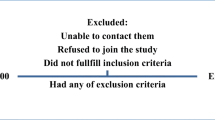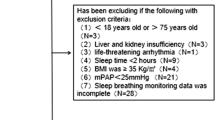Abstract
Introduction
Overlap syndrome is the association of obstructive sleep apnea (OSA) with chronic obstructive pulmonary disorder and with other chronic respiratory diseases. Patients with overlap syndrome have a worse prognosis compared with chronic obstructive pulmonary disorder or OSA alone. Additionally, patients with combined chronic obstructive pulmonary disorder and OSA are more likely to develop pulmonary hypertension and right heart failure much earlier than those without overlap.
Aim
To assess the occurrence of pulmonary hypertension (PH) in newly diagnosed OSA-chronic obstructive pulmonary disorder overlap syndrome patients attending a tertiary care centre.
Materials and methods
This cross-sectional study was conducted at Department of Pulmonary Medicine, Government Medical College, Kozhikode, Kerala, South India, among patients with OSA above 40 years of age who were proactively evaluated to pick out those with undiagnosed overlap. A period of 6 months after getting ethical clearance from June 2018 was selected as the study period. Among patients with symptoms suggestive of OSA above 40 years of age who gave the informed consent were enrolled after screening with Standard Sleep questionnaires (Berlin questionnaire, STOP BANG and Epworth Sleepiness Scale). Enrolled patients underwent routine spirometry and sleep study using the standard Level 1 overnight polysomnography (Level1 OPSG). Patients were classified in to two groups as OSA patients (group I), having an apnea hypopnea index (AHI) > 5/hr alone and the second group as those OSA patients (group II), with an obstructive spirometry pattern who were the overlap group. Arterial blood gas analysis (a sample of radial arterial blood was drawn with the patient awake and supine, and was analyzed for pH, PaCO2 and PaO2) and echocardiography (ECHO) of the two groups were compared as a non-invasive method to assess pulmonary artery hypertension and results were analyzed in a systematic manner.
Results
Among the 84 patients enrolled, 16.7% had overlap syndrome and the rest had OSA alone. Statistically significant higher mean weight and BMI for those with overlap syndrome compared to the OSA group were observed. Mean FVC (forced vital capacity), FEV1 (forced expiratory volume 1 s), and FEV1/FVC were lower in those with overlap syndrome compared to OSA group. The mean values of ABG parameters revealed higher PaCO2 and lower PaO2 among the group with overlap syndrome which were statistically significant. However, there was no significant difference in resting room air SaO2 value between the two groups. The mean values of sleep duration and efficiency were significantly lower in those with overlap syndrome with a p value < 0.001. The mean value of arousal and REM (rapid eye movement) sleep percentage were significantly higher among those with overlap syndrome (p < 0.001). Mean value of NREM (non-rapid eye movement) sleep percentage was lower among the group with overlap syndrome compared with the OSA group, and this difference was statistically significant. The mean AHI value of the overlap syndrome group was 39.79 ± 7.54 and this was significantly higher than the OSA group (p < 0.004). Among the 14 patients who had ECHO evidence of pulmonary hypertension, 9 (64.3%) belonged to the overlap group which shows that they are a highly vulnerable group for developing pulmonary hypertension (PH) and requires early detection and more rigorous treatment.
Conclusion
This study confirms that OSA patients with modest daytime level of hypoxemia and mild-moderate chronic airflow limitation have a high prevalence of PH. Chronic airway obstruction may be asymptomatic in some subjects and this stresses the necessity of pulmonary function test in OSA.


Similar content being viewed by others
References
Flenley DC (1985) Sleep in chronic obstructive lung disease. Clin Chest Med 6:51–61. https://doi.org/10.1016/S0272-5231(21)00402-0. (ISSN 0272–5231)
Sharma SK, Malik V, Vasudev C et al (2006) Prediction of obstructive sleep apnea in patients presenting to a tertiary care center. Sleep Breath 10:147–154
Jindal SK, Aggarwal AN, Gupta D (2001) A review of the population studies from India to estimate national burden of chronic obstructive pulmonary disease and its association with smoking. Indian J Chest Dis Allied Sci 43:139–147
Kouismi H, El Ftouh M, Naji-Amrani H, El Fihry ME (2013) Overlap syndrome: association of chronic obstructive pulmonary disease and obstructive sleep apnea syndrome. Egypt J Chest Dis Tuberc 62:583–587
Rizzi M, Palma P, Andreoli A et al (1997) Prevalence and clinical feature of the “overlap syndrome”, obstructive sleep apnea (OSA) and chronic obstructive pulmonary disease (COPD), in OSA population. Sleep Breath 2:68
McNicholas WT (2017) COPD-OSA overlap syndrome: evolving evidence regarding epidemiology, clinical consequences, and management. Chest 152(6):1318–1326. https://doi.org/10.1016/j.chest.2017.04.160. (Epub 2017 Apr 23 PMID: 28442310)
Marin JM, Soriano JB, Carrizo SJ et al (2010) Outcomes in patients with chronic obstructive pulmonary disease and obstructive sleep apnea: the overlap syndrome. Am J Respir Crit Care Med 182:325–331
Laks L, Lehrhaft B, Grunstein RR et al (1995) Pulmonary hypertension in obstructive sleep apnoea. Eur Respir J 8(4):537–541 (PubMed: 7664850)
Sin DD, Man SF (2005) Chronic obstructive pulmonary disease as a risk factor for cardiovascular morbidity and mortality. Proc Am Thorac Soc 2(1):8–11 (PubMed: 16113462)
Agustí A (2007) Systemic effects of chronic obstructive pulmonary disease: what we know and what we don’t know (but should). Proc Am Thorac Soc 4(7):522–525. https://doi.org/10.1513/pats.200701-004FM. (PMID: 17878464)
Sajkov D, McEvoy RD (2009) Obstructive sleep apnea and pulmonary hypertension. Prog Cardiovasc Dis 51(5):363–370 (PubMed: 19249442)
Bradley TD, Rutherford R, Grossman RF et al (1985) Role of daytime hypoxemia in the pathogenesis of right heart failure in the obstructive sleep apnea syndrome. Am Rev Respir Dis 131(6):835–839 (PubMed: 4003933)
Bradley TD, Rutherford R, Lue F et al (1986) Role of diffuse airway obstruction in the hypercapnia of obstructive sleep apnea. Am Rev Respir Dis 134(5):920–924 (PubMed: 3777688)
Author information
Authors and Affiliations
Corresponding author
Ethics declarations
Conflict of interest
The authors declare no competing interests.
Additional information
Publisher's Note
Springer Nature remains neutral with regard to jurisdictional claims in published maps and institutional affiliations.
Rights and permissions
Springer Nature or its licensor (e.g. a society or other partner) holds exclusive rights to this article under a publishing agreement with the author(s) or other rightsholder(s); author self-archiving of the accepted manuscript version of this article is solely governed by the terms of such publishing agreement and applicable law.
About this article
Cite this article
Reshma S, J., George, S. & P, S.K. Pulmonary hypertension in newly diagnosed obstructive sleep apnea-chronic obstructive pulmonary disease overlap syndrome patients attending a tertiary care centre—a cross-sectional analysis. Ir J Med Sci (2024). https://doi.org/10.1007/s11845-024-03657-x
Received:
Accepted:
Published:
DOI: https://doi.org/10.1007/s11845-024-03657-x




